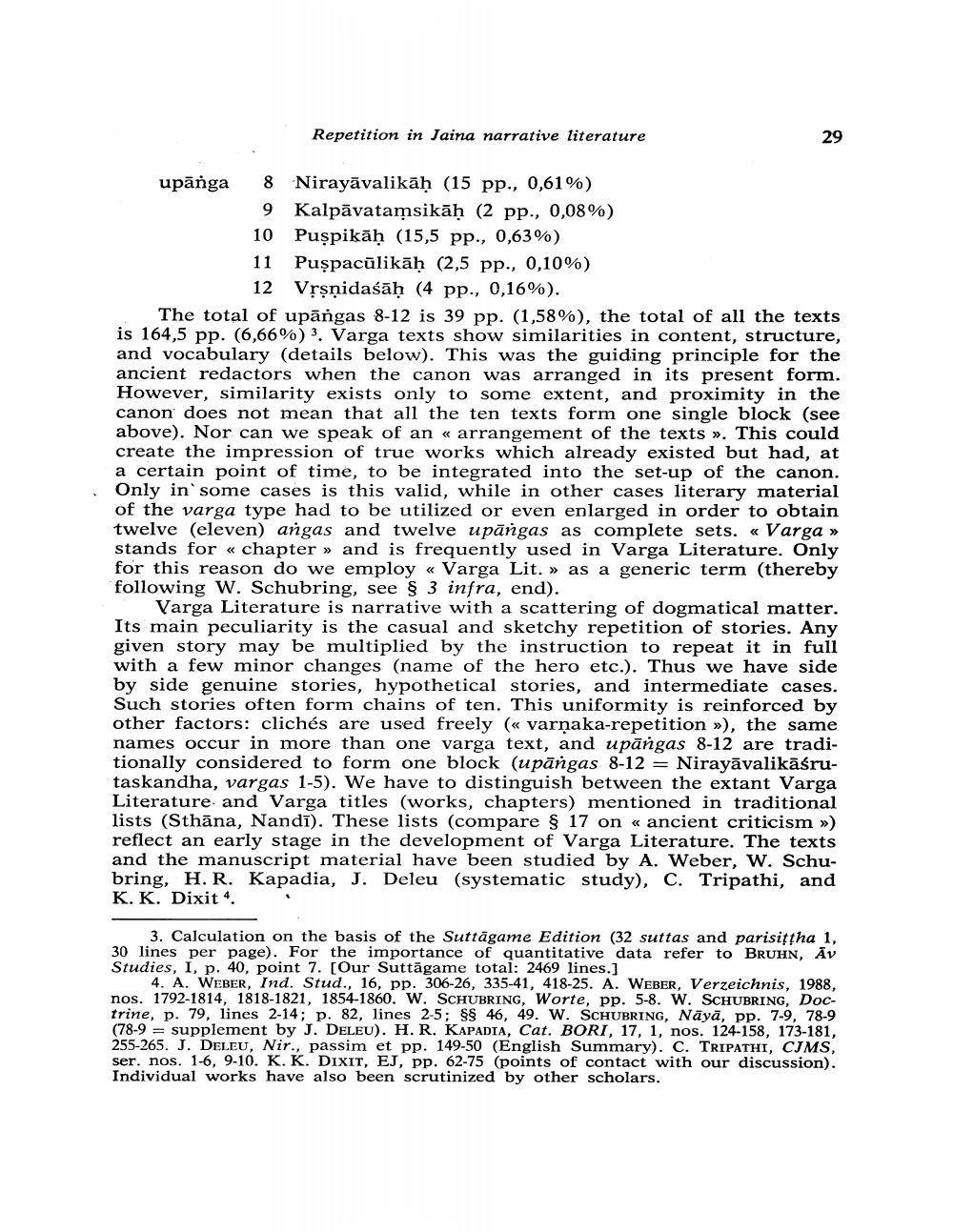Book Title: Repetition In Jaina Nrative Literature Author(s): Klaus Bruhn Publisher: Klaus Bruhn View full book textPage 3
________________ Repetition in Jaina narrative literature 29 upānga 8 Nirayāvalikāḥ (15 pp., 0,61%) 9 Kalpāvatamsikāḥ (2 pp., 0,08%) 10 Puspikāḥ (15,5 pp., 0,63%) 11 Pușpacālikāḥ (2,5 pp., 0,10%) 12 Vrsņidaśāḥ (4 pp., 0,16%). The total of upāngas 8-12 is 39 pp. (1,58%), the total of all the texts is 164,5 pp. (6,66%) 3. Varga texts show similarities in content, structure, and vocabulary (details below). This was the guiding principle for the ancient redactors when the canon was arranged in its present form. However, similarity exists only to some extent, and proximity in the canon does not mean that all the ten texts form one single block (see above). Nor can we speak of an « arrangement of the texts ». This could create the impression of true works which already existed but had, at a certain point of time, to be integrated into the set-up of the canon. Only in some cases is this valid, while in other cases literary material of the varga type had to be utilized or even enlarged in order to obtain twelve (eleven) angas and twelve upāngas as complete sets. «Varga » stands for « chapter and is frequently used in Varga Literature. Only for this reason do we employ « Varga Lit. » as a generic term (thereby following W. Schubring, see § 3 infra, end). Varga Literature is narrative with a scattering of dogmatical matter. Its main peculiarity is the casual and sketchy repetition of stories. Any given story may be multiplied by the instruction to repeat it in full with a few minor changes (name of the hero etc.). Thus we have side by side genuine stories, hypothetical stories, and intermediate cases. Such stories often form chains of ten. This uniformity is reinforced by other factors: clichés are used freely (« varņaka-repetition »), the same names occur in more than one varga text, and u pāngas 8-12 are traditionally considered to form one block (upāngas 8-12 = Nirayāvalikāśrutaskandha, vargas 1-5). We have to distinguish between the extant Varga Literature and Varga titles (works, chapters) mentioned in traditional lists (Sthāna, Nandī). These lists (compare § 17 on « ancient criticism ») reflect an early stage in the development of Varga Literature. The texts and the manuscript material have been studied by A. Weber, W. Schubring, H.R. Kapadia, J. Deleu (systematic study), C. Tripathi, and K. K. Dixit 3. Calculation on the basis of the Suttāgame Edition (32 suttas and parisittha 1, 30 lines per page). For the importance of quantitative data refer to BRUHN, Āv Studies, I, p. 40, point 7. [Our Suttāgame total: 2469 lines.) 4. A. WEBER, Ind. Stud., 16, pp. 306-26, 335-41, 418-25. A. WEBER, Verzeichnis, 1988, nos. 1792-1814, 1818-1821, 1854-1860. W. SCHUBRING, Worte, pp. 5-8. W. SCHUBRING, Doctrine, p. 79, lines 2-14; p. 82, lines 2-5; SS 46, 49. W. SCHUBRING, Nāyā, pp. 7-9, 78-9 (78-9 = supplement by J. DELEU). H. R. KAPADIA, Cat. BORI, 17, 1, nos. 124-158, 173-181, 255-265. J. DELEU, Nir., passim et pp. 149-50 (English Summary). C. TRIPATHI, CIMS, ser. nos. 1-6, 9-10. K.K. DIXIT, EJ, pp. 62-75 (points of contact with our discussion). Individual works have also been scrutinized by other scholars.Page Navigation
1 2 3 4 5 6 7 8 9 10 11 12 13 14 15 16 17 18 19 20 21 22 23 24 25 26 27 28 29 30 31 32 ... 49
